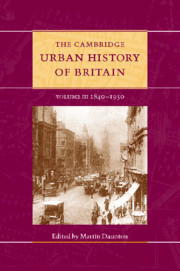Book contents
- Frontmatter
- 1 Introduction
- Part I Circulation
- Part II Governance
- Part III Construction
- Part IV Getting and spending
- 18 Industrialisation and the city economy
- 19 The urban labour market
- 20 Urban fertility and mortality patterns
- 21 The middle class
- 22 Towns and consumerism
- 23 Playing and praying
- Part V Images
- Select bibliography
- Index
- Plates 1-7
- Plates 8-14
- Plates 15-20
- Plates 21-27
- Plates 28-34
- Plates 35-41
- Plates 42-48>
- Plates 49-53
- References
18 - Industrialisation and the city economy
from Part IV - Getting and spending
Published online by Cambridge University Press: 28 March 2008
- Frontmatter
- 1 Introduction
- Part I Circulation
- Part II Governance
- Part III Construction
- Part IV Getting and spending
- 18 Industrialisation and the city economy
- 19 The urban labour market
- 20 Urban fertility and mortality patterns
- 21 The middle class
- 22 Towns and consumerism
- 23 Playing and praying
- Part V Images
- Select bibliography
- Index
- Plates 1-7
- Plates 8-14
- Plates 15-20
- Plates 21-27
- Plates 28-34
- Plates 35-41
- Plates 42-48>
- Plates 49-53
- References
Summary
At its simplest, entirely new factory towns were created by industrialisation. This subspecies of the industrial city was the result of evolving technological developments and changing advantages associated with different industrial locations. New Lanark, Styal, Middlesbrough, Clydebank and Slough shared this lineage, as did many factory villages, some of which enjoyed only the briefest of expansionary phases before stagnation set in and obscurity beckoned. All were essentially the product of industrialisation, dependent upon the rhythms established by the industries themselves. Yet the drama of such industrial transformations distracts from a fuller understanding of the complexity of the relationship between industry and the city. Urbanisation and industrialisation were interwoven processes driving economic change during the nineteenth century and the British industrial city in the modern period was a complex and evolving genus. It was both influenced by the fortunes of the major growth industries in the national economy – coal, textiles, iron and steel, ship-building – and also itself contributed to economic growth. Even by mid-century a wide array of other industries had been established within the towns as had service industries and distributive functions to support urban growth.
While the trajectory of the growth in the established industrial and market centres undoubtedly was influenced by technological development and a common reservoir of commercial knowledge, the precise path of urban expansion depended to a considerable extent on the resources, facilities, expertise and personal networks created within such towns and cities. Indeed, the defence of local autonomy and opposition to centralisation in the nineteenth century was in part an attempt to maintain those distinctive urban features that contributed to the prosperity of local inhabitants.
Keywords
- Type
- Chapter
- Information
- The Cambridge Urban History of Britain , pp. 551 - 592Publisher: Cambridge University PressPrint publication year: 2001
References
- 3
- Cited by

